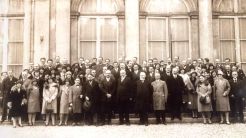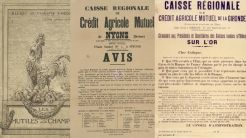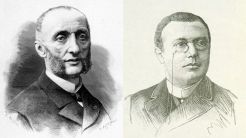
Crédit Agricole 140 years of history: 1980s - The beginnings of universal banking
In the early 1980s, Crédit Agricole operated throughout France, including in the largest urban areas. It also began to develop its international network with a growing number of new locations (Frankfurt, Milan, Cairo, Singapore, etc.).
Further extensions of its scope of action allowed it to serve all types of customers, from households to businesses, and all economic sectors. Crédit Agricole was on track to become a universal bank, which it fully achieved in 1991 with the lifting of the last restrictions on corporate and investment banking.
To meet the needs of its customers, particularly in terms of savings, it embarked on a different activity from banking with the creation of Predica, its life insurance subsidiary. This was soon a great success and contributed to ranking the Group among the leaders in bancassurance.
This gradual transformation of Crédit Agricole from a financial institution specialised in farming to a universal bank serving all types of customers occurred despite the fact that its structure had barely changed since 1920. The Caisse Nationale was still a public entity under government supervision, serving as the central institution for the regional banks, private cooperative companies. However, the regional banks wanted to take control of the Group’s fate by freeing it from the public authorities. Therefore, in 1987, they bought the capital of the Caisse Nationale from the government and became the majority shareholders. This operation was referred to as the mutualisation of the Caisse Nationale.
Three posters showing Crédit Agricole’s three activities in the 1980s: retail banking, international trade and life insurance
The Crédit Agricole logo since 1987
To demonstrate the institutional change, a new visual identity was deployed with the adoption of the logo which is still used today.
In the same series
-
 Crédit Agricole 140 years of history: 2025 until todayCrédit Agricole is now an original model of universal retail banking.
Crédit Agricole 140 years of history: 2025 until todayCrédit Agricole is now an original model of universal retail banking. -
 Crédit Agricole 140 years of history: 2010s - The expression of our “Raison d’être”At the beginning of this decade, Crédit Agricole: included 39 regional banks, fully-fledged banks and the majority shareholders of the central institution Crédit Agricole S.A.; was active in all banking businesses; provided services to all types of customers, from individuals to corporates and institutional investors, from the most vulnerable to the wealthiest; included a second retail banking network, LCL; was present throughout France and on all continents.
Crédit Agricole 140 years of history: 2010s - The expression of our “Raison d’être”At the beginning of this decade, Crédit Agricole: included 39 regional banks, fully-fledged banks and the majority shareholders of the central institution Crédit Agricole S.A.; was active in all banking businesses; provided services to all types of customers, from individuals to corporates and institutional investors, from the most vulnerable to the wealthiest; included a second retail banking network, LCL; was present throughout France and on all continents. -
 Crédit Agricole 140 years of history: 2000s - A new dimensionIn 2001, the regional banks, the majority shareholders of Caisse Nationale de Crédit Agricole, decided to open up its capital to the public.
Crédit Agricole 140 years of history: 2000s - A new dimensionIn 2001, the regional banks, the majority shareholders of Caisse Nationale de Crédit Agricole, decided to open up its capital to the public. -
 Crédit Agricole 140 years of history: 1990s - A growing groupCrédit Agricole, no longer under government supervision, was now in control of its destiny. It completed its goal of becoming a universal bank with the ambition of being useful to all.
Crédit Agricole 140 years of history: 1990s - A growing groupCrédit Agricole, no longer under government supervision, was now in control of its destiny. It completed its goal of becoming a universal bank with the ambition of being useful to all. -
 Crédit Agricole 140 years of history: 1970s - From rural to internationalFrom 1971, Crédit Agricole’s geographical scope gradually expanded.
Crédit Agricole 140 years of history: 1970s - From rural to internationalFrom 1971, Crédit Agricole’s geographical scope gradually expanded. -
 Crédit Agricole 140 years of history: 1960s - A decade of renewalSince 1897, Crédit Agricole received advances from the government each year, which it had to repay.
Crédit Agricole 140 years of history: 1960s - A decade of renewalSince 1897, Crédit Agricole received advances from the government each year, which it had to repay. -
 Crédit Agricole 140 years of history: 1950s - Expansion of the networkIn the early 1950s, Crédit Agricole developed savings inflows to boost financing for French farmers.
Crédit Agricole 140 years of history: 1950s - Expansion of the networkIn the early 1950s, Crédit Agricole developed savings inflows to boost financing for French farmers. -
 Crédit Agricole 140 years of history: 1940s - War and reconstructionThe Second World War disrupted the organisation of Crédit Agricole.
Crédit Agricole 140 years of history: 1940s - War and reconstructionThe Second World War disrupted the organisation of Crédit Agricole. -
 Crédit Agricole 140 years of history : 1930s - Helping farmers through the crisisThe 1929 crisis that began in the United States reached France in the following years.
Crédit Agricole 140 years of history : 1930s - Helping farmers through the crisisThe 1929 crisis that began in the United States reached France in the following years. -
 Crédit Agricole 140 years of history : 1920s - Electricity and housingThe birth of the Caisse Nationale de Crédit Agricole
Crédit Agricole 140 years of history : 1920s - Electricity and housingThe birth of the Caisse Nationale de Crédit Agricole -
 Crédit Agricole 140 years of history : 1910s - Serving the entire countryAt this time, two important measures strengthened Crédit Agricole’s action in its fight against rural depopulation.
Crédit Agricole 140 years of history : 1910s - Serving the entire countryAt this time, two important measures strengthened Crédit Agricole’s action in its fight against rural depopulation. -
 Crédit Agricole 140 years of history : 1900s - First extension of the scope of actionThe first decade of the 20th century saw Crédit Agricole establish a lasting presence in the regions.
Crédit Agricole 140 years of history : 1900s - First extension of the scope of actionThe first decade of the 20th century saw Crédit Agricole establish a lasting presence in the regions. -
 Crédit Agricole 140 years of history : 1890s - A bottom-up organisationCreation of the local banks
Crédit Agricole 140 years of history : 1890s - A bottom-up organisationCreation of the local banks -
 Crédit Agricole 140 years of history : 1880s - Creation in the JuraOur story begins in 1885 in Salins-les-Bains in the Jura.
Crédit Agricole 140 years of history : 1880s - Creation in the JuraOur story begins in 1885 in Salins-les-Bains in the Jura.










